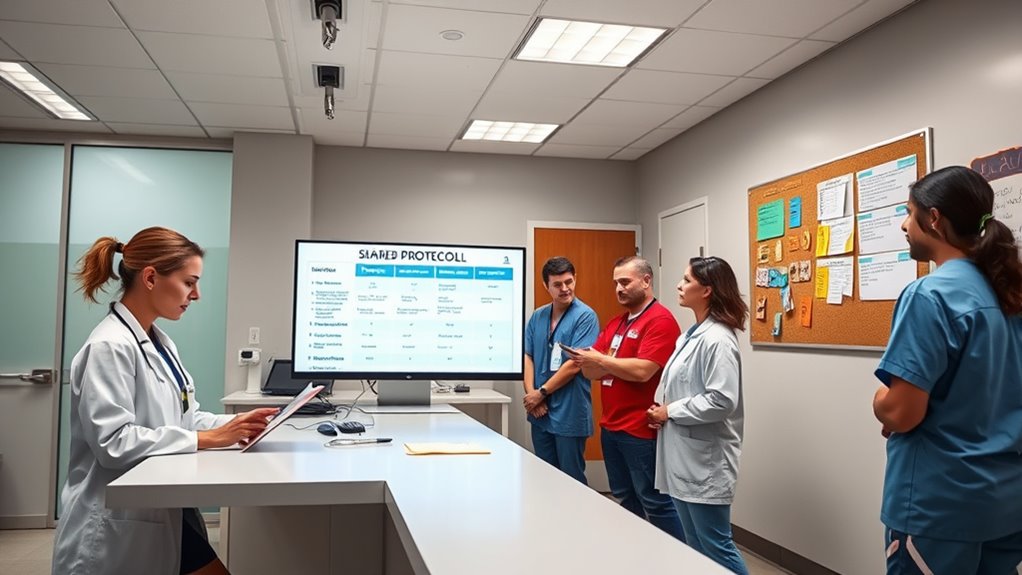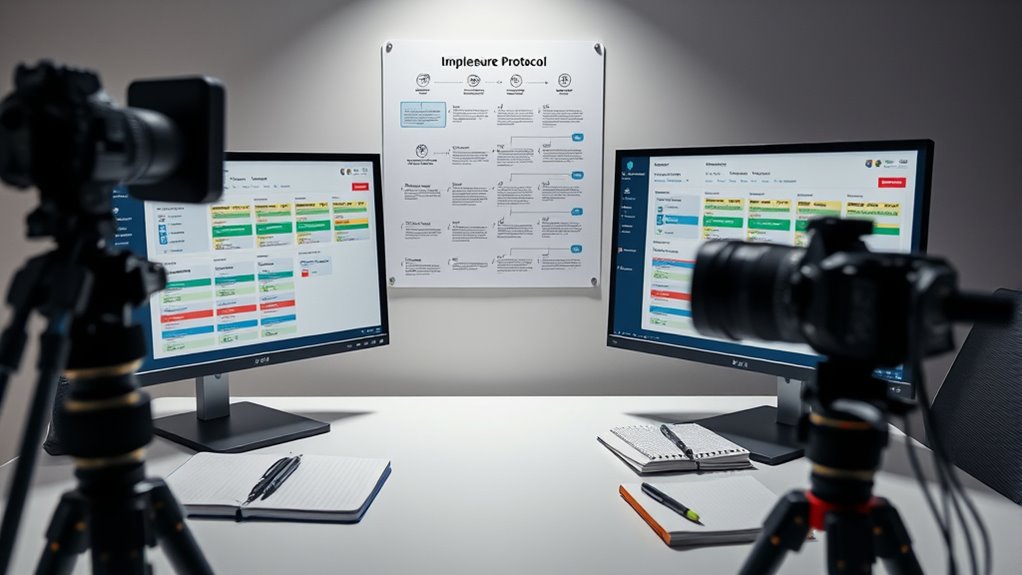Implementing a shared issue triage protocol helps you streamline how your team identifies, prioritizes, and resolves problems effectively. By defining clear criteria for severity levels, assigning specific roles, and using collaborative tools, you can guarantee consistent handling and quicker responses. Automating routine tasks further enhances efficiency. Regularly monitoring and refining your approach keeps the process resilient. If you want to understand how to build a robust triage system, keep exploring these essential steps.
Key Takeaways
- Establish clear severity levels and impact criteria to prioritize issues effectively.
- Define roles and responsibilities for assessors, escalators, and resolvers to ensure coordinated response.
- Automate routine triage tasks like issue assignment and escalation to improve efficiency.
- Use standardized documentation and logs for consistent issue tracking and faster resolution.
- Continuously monitor, review, and refine triage processes based on feedback and performance metrics.
Understanding the Importance of Unified Issue Triage

Have you ever wondered why some issue management systems run smoothly while others struggle to prioritize effectively? The key lies in unified issue triage, where clear procedures guide how issues are handled. When everyone follows the same process, issue escalation becomes more consistent, preventing delays and confusion. Stakeholder collaboration is essential here, ensuring all relevant parties are involved early and understand their roles. A shared triage approach helps teams quickly identify critical problems, assign responsibilities, and track progress transparently. Without unity, issues can slip through the cracks or be misclassified, leading to inefficiencies. Implementing a structured security assessment process enhances overall issue resolution. Additionally, establishing emotional support strategies within teams can foster resilience and improve communication during challenging times. Ultimately, a well-coordinated triage process keeps issues manageable, promotes accountability, and supports swift resolution, making your entire issue management system more effective and resilient.
Establishing Clear Criteria for Issue Severity and Priority

To effectively prioritize issues, you need to establish clear criteria for severity and urgency. This helps with issue categorization and guarantees everyone understands the importance of each problem. Start by defining severity levels, such as:
- Critical – causes system failure or data loss and needs immediate attention.
- High – impacts functionality but has workarounds; address quickly.
- Medium – minor inconvenience; scheduled for later.
- Low – cosmetic or trivial issues; tackled as time permits. Additionally, considering the contrast ratio of visual displays can help determine the impact of display-related issues on user experience. Incorporating a comprehensive issue assessment process can further improve prioritization by evaluating factors like affected users and potential downtime, as well as how the issue affects overall user satisfaction.
Designing an Effective Triage Workflow

To design an effective triage workflow, you need to prioritize issue severity to address the most critical problems first. Clearly define triage roles so everyone knows their responsibilities and responds efficiently. Automating routine triage steps can save time and reduce errors, ensuring a smooth process from start to finish. Incorporating product reviews can help identify common issues and inform better prioritization. Recognizing warning signs early can prevent unresolved issues from escalating and affecting overall performance. Ensuring the authenticity of brand reputation can further streamline issue resolution and maintain trust. Paying attention to nutritional information related to products can aid in better understanding user concerns and potential health impacts. Implementing analytics cookies enables continuous improvement and more accurate issue tracking.
Prioritize Issue Severity
Prioritizing issue severity is a crucial step in designing an effective triage workflow because it guarantees that the most critical problems are addressed promptly. Your goal is to create a clear process for issue classification and establish escalation criteria. To do this: 1. Assess the impact and urgency of each issue to determine its severity level. 2. Use consistent criteria to classify issues, making sure everyone understands the priorities. 3. Define escalation pathways for high-severity problems that require immediate attention. 4. Regularly review and update severity levels to reflect evolving priorities and ensure effective resource allocation. Incorporating standardized classification helps maintain consistency across teams and enhances overall response efficiency. Additionally, understanding how sound healing science can influence stress reduction and emotional well-being can inform approaches to managing high-severity issues that involve mental health components. Recognizing the personality traits of team members can further optimize triage workflows by assigning tasks according to individual strengths. Using color-coded systems for severity levels can also streamline decision-making and communication during high-pressure situations, especially when combined with effective marketing strategies to improve team coordination.
Define Triage Roles
Who should be responsible for managing the triage process? Typically, a designated triage lead or team manages this role, guaranteeing clear issue escalation procedures and effective triage team composition. Your triage team should include members with diverse expertise to accurately assess severity and prioritize issues. Assign roles such as initial assessor, escalator, and resolver to streamline workflow. Clear roles prevent confusion, reduce delays, and ensure issues are addressed promptly. Define responsibilities upfront so each team member knows their part in evaluating and escalating issues. Proper triage role definition helps maintain a consistent process, improves communication, and ensures the right issues reach the right people quickly, setting the foundation for an efficient triage workflow. Reliable troubleshooting protocols are essential to ensure consistent issue assessment and resolution. Incorporating safety considerations into the triage process is vital, especially when dealing with electrical devices like heated mattress pads, to prevent hazards and ensure user safety. Additionally, understanding personality traits and preferences can facilitate better communication within the triage team, leading to more effective problem-solving. Furthermore, integrating personal growth and development principles can enhance team dynamics and improve overall triage effectiveness.
Automate Triage Steps
Have you considered how automation can streamline your triage workflow? Automating triage steps helps reduce delays and ensures consistent issue escalation. To do this effectively, focus on these key actions:
- Set rules for automatic issue assignment based on keywords or severity.
- Implement alerts for urgent issues needing immediate escalation.
- Create feedback loops that trigger review or reassignment if issues persist.
- Use dashboards to monitor triage progress and identify bottlenecks.
- Be aware of cookie categories and their roles in supporting automated workflows, ensuring transparency and compliance. Additionally, understanding cost and budgeting can inform how you allocate resources for automation tools and infrastructure, optimizing your triage efficiency. Incorporating emotional regulation principles from somatic therapy can also enhance team resilience and response quality during high-pressure situations.
These steps ensure issues are routed quickly and escalated appropriately, minimizing manual intervention. Automation also fosters continuous improvement by providing real-time insights, allowing you to refine your triage process. By designing an efficient, automated workflow, you make issue escalation smoother and strengthen your feedback loops for better resolution management.
Utilizing Collaborative Tools for Seamless Communication

Effective communication is essential when managing issue triage, and collaborative tools play a pivotal role in ensuring seamless information flow. Virtual collaboration platforms enable your team to share insights and updates instantly, fostering a unified approach. These tools support real-time updates, so everyone stays informed about progress and changes without delays. By integrating chat apps, shared documents, and issue tracking systems, you reduce misunderstandings and streamline decision-making. You can quickly coordinate efforts, ask questions, and clarify details, all within a centralized environment. This constant, transparent communication helps prevent issues from slipping through the cracks and accelerates resolution times. Ultimately, using collaborative tools elevates your triage process, making it more efficient and responsive to evolving challenges.
Assigning Roles and Responsibilities in the Triage Process

To guarantee an effective triage process, you need clear role clarification and responsibility assignment. Defining who handles each part of the workflow helps prevent confusion and delays. By establishing these roles, you set the foundation for a smooth and efficient issue management system.
Role Clarification
Clear role clarification is essential for a smooth triage process, as it guarantees everyone knows their specific responsibilities from the outset. When roles are clear, you improve role clarity and ensure effective task delegation. To achieve this, consider:
- Defining each team member’s specific duties upfront.
- Communicating expectations clearly to avoid confusion.
- Assigning responsibilities based on expertise and workload.
- Confirming understanding to prevent overlaps or gaps.
Responsibility Assignment
Once roles are defined, the next step is to assign responsibilities that align with each team member’s skills and current workload. Clear ownership clarity guarantees everyone knows who’s responsible for each task, reducing confusion and overlap. When assigning responsibilities, consider each person’s strengths and capacity to maintain accountability measures effectively. This clarity fosters a sense of ownership, encouraging team members to take initiative and follow through without ambiguity. By explicitly defining who handles specific issues, you minimize gaps or duplicated efforts. Regularly communicate these responsibilities to reinforce understanding and ensure everyone is aligned. Well-assigned responsibilities promote accountability, making it easier to track progress and address issues promptly, keeping the triage process efficient and transparent.
Triage Workflow
How do you guarantee that each step in the triage process runs smoothly? Clear roles and responsibilities are key. First, define who handles initial issue escalation to prevent delays. Second, assign specific team members to assess severity and triage metrics, ensuring quick, accurate decisions. Third, establish accountability for updating issue statuses and communicating progress. Fourth, hold regular reviews to refine the workflow and adjust roles as needed. This keeps everyone aligned and minimizes bottlenecks. When roles are clear, issues flow efficiently through the process, reducing confusion and delays. Effective triage workflow ensures issues are escalated properly, tracked with reliable triage metrics, and resolved swiftly. Consistent role assignment creates a proactive environment where issues are managed seamlessly from start to finish.
Implementing Standardized Documentation and Logging

Implementing standardized documentation and logging is essential for effective issue triage, as it guarantees that all relevant information is consistently captured and easily accessible. When you establish clear protocols for issue tracking, your team can quickly identify patterns, prioritize issues, and avoid redundant work. Protocol documentation ensures everyone understands the steps to record issue details, such as error messages, timestamps, and affected systems. Consistent logging helps maintain a reliable audit trail, enabling faster diagnosis and resolution. By standardizing how you document issues, you reduce miscommunication and improve collaboration across teams. This systematic approach streamlines the triage process, saves time, and enhances overall efficiency, making sure that critical issues are addressed promptly and accurately.
Training Teams on the Shared Protocol

To guarantee your team effectively follows the shared protocol for issue triage, vital training is essential. Engaged team motivation drives better learning outcomes and boosts training effectiveness. To achieve this, focus on:
- Clearly explaining the purpose and benefits of the protocol
- Using interactive sessions to keep everyone involved
- Providing real-world scenarios for practical understanding
- Gathering feedback to improve training and address concerns
Monitoring and Refining the Triage System

Regularly monitoring your triage system guarantees it remains effective and responsive to evolving issues. You should track how issues escalate through your process, ensuring escalation paths are clear and efficient. Pay attention to feedback loops from team members, clients, and stakeholders to identify bottlenecks or gaps. Use this information to refine your procedures, making adjustments to triage criteria or communication protocols as needed. Consistent review helps you catch recurring problems early and adapt your system before issues worsen. By actively monitoring performance metrics and listening to feedback, you create a cycle of continuous improvement. This approach ensures your triage system stays aligned with your team’s needs and organizational goals, ultimately supporting quicker, more accurate issue resolution.
Benefits of a Consistent Issue Handling Approach

A consistent approach to issue handling guarantees your team responds efficiently and reliably every time a problem arises. It streamlines issue escalation, ensuring urgent problems are prioritized correctly. Clear protocols improve stakeholder communication, keeping everyone informed and aligned. With a shared process, your team can:
- Quickly identify and categorize issues, reducing resolution time.
- Ensure proper issue escalation paths are followed, avoiding delays.
- Maintain transparent stakeholder updates, building trust.
- Minimize confusion by applying uniform procedures, reducing errors.
This consistency not only boosts your team’s confidence but also enhances overall service quality. When everyone follows the same protocol, you minimize miscommunication and deliver predictable results. Ultimately, a shared, standardized approach creates a resilient system ready to tackle issues effectively.
Frequently Asked Questions
How Often Should the Triage Protocol Be Reviewed and Updated?
You should review the triage protocol at least quarterly to guarantee it stays effective. Regular review frequency helps you identify any gaps or outdated procedures. When you find necessary updates, follow clear update procedures to make revisions smoothly and maintain consistency. This proactive approach keeps your triage process efficient, accurate, and aligned with current needs, ultimately improving issue resolution and team response times.
What Challenges Might Teams Face When Adopting a Shared Triage System?
When adopting a shared triage system, you might face challenges like communication breakdowns and inconsistent prioritization. These issues can cause confusion, delays, and frustration among team members. To overcome them, guarantee clear communication channels, regular training, and updated guidelines. Aligning everyone’s understanding and expectations helps mitigate these problems, fostering a smoother triage process. Addressing these challenges early improves collaboration and ensures issues are prioritized effectively across the team.
How Can We Ensure Remote Teams Adhere to the Triage Process?
You can guarantee remote teams adhere to the triage process by fostering remote accountability through regular check-ins and clear expectations. Providing thorough triage training helps team members understand their roles and procedures, reducing errors and confusion. Using collaborative tools for transparency and tracking ensures everyone stays aligned. Encourage open communication and feedback to reinforce adherence, making the triage system a consistent part of your remote team’s workflow.
What Are Common Mistakes to Avoid During Issue Triage?
You should avoid prioritization errors that lead to misclassified issues, which can cause delays or overlooked problems. Be careful to prevent communication breakdowns by clearly documenting and sharing triage decisions with your team. Always verify that everyone understands their roles and the severity of issues. Stay vigilant about these mistakes to ensure smooth, efficient issue resolution and maintain trust and clarity within your remote team.
How Does Issue Triage Integrate With Existing Incident Management Frameworks?
You integrate issue triage with incident management frameworks by aligning prioritization strategies and communication workflows. You prioritize issues based on severity and impact, guaranteeing swift responses. You establish clear communication channels to keep stakeholders informed and coordinated. This seamless integration helps you streamline resolution processes, avoid duplication, and ensure consistent handling of incidents, ultimately minimizing downtime and improving service reliability.
Conclusion
By adopting this shared issue triage protocol, you’ll transform chaos into clarity, turning your team’s response time from sluggish to lightning-fast. When everyone follows the same steps, communication becomes seamless, and issues get resolved with unmatched efficiency. This isn’t just about fixing problems—it’s about creating a powerhouse of collaboration that drives your success forward. Embrace the system, and watch your issue management skyrocket to extraordinary heights!









